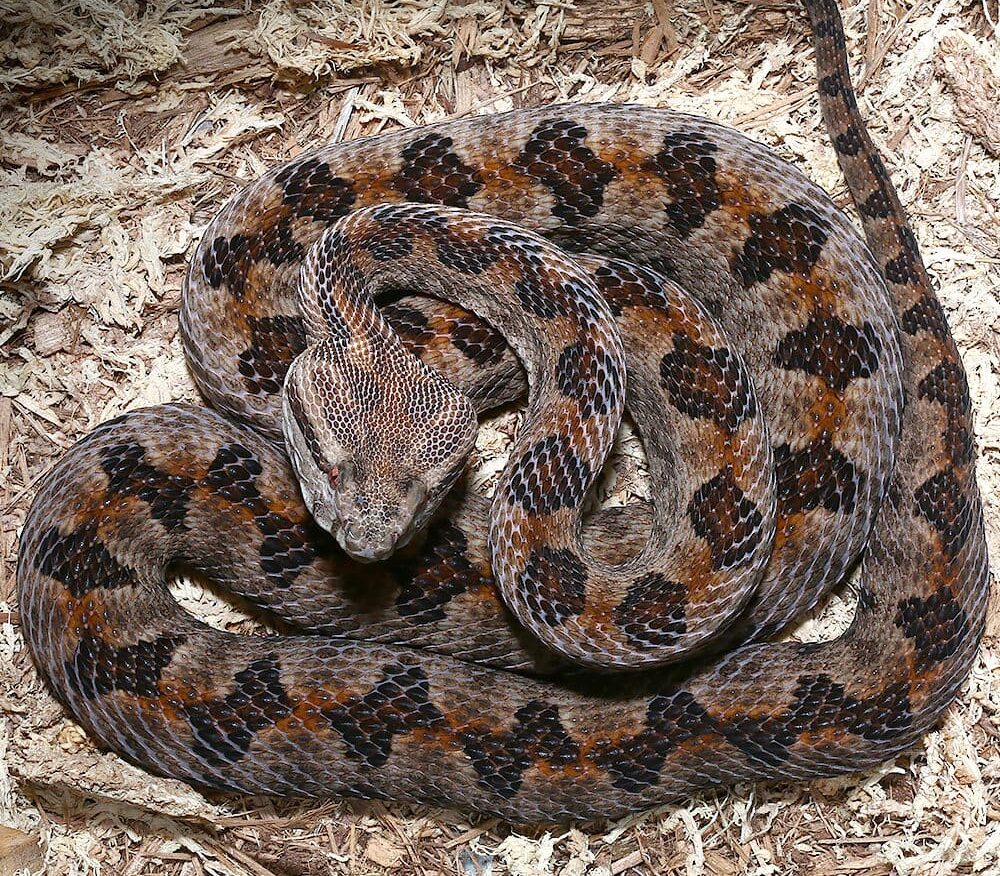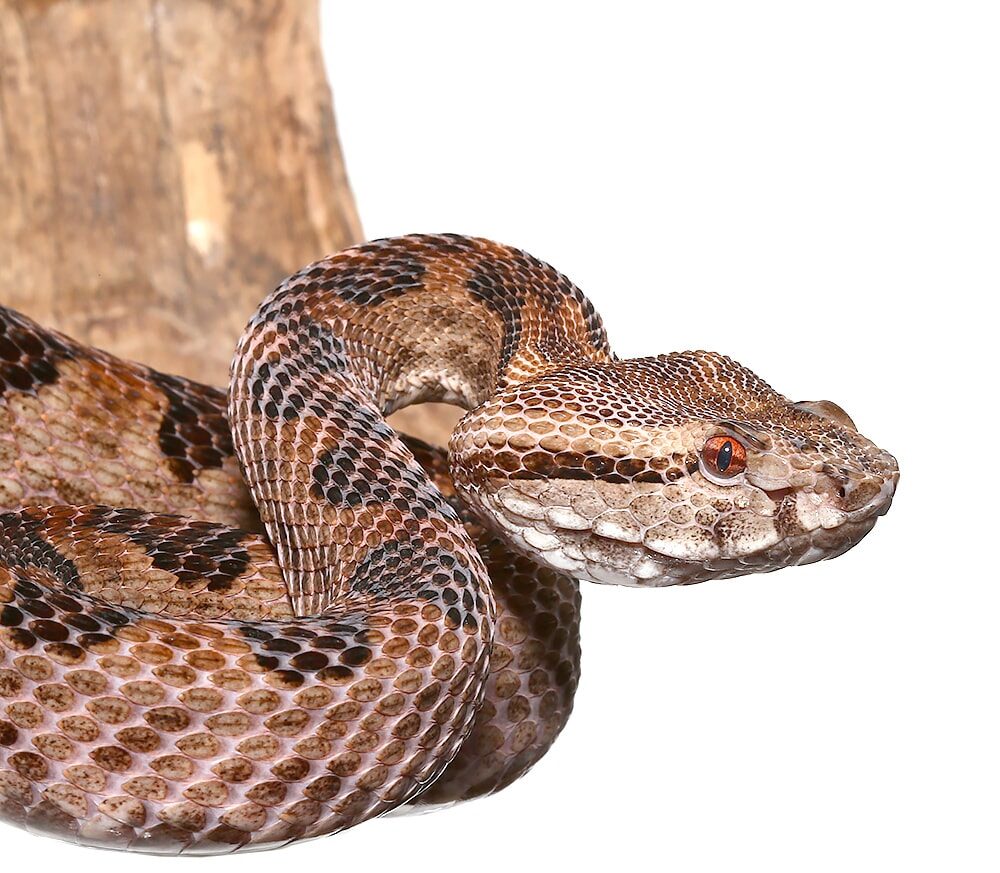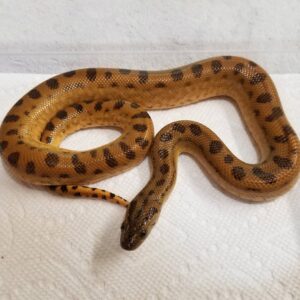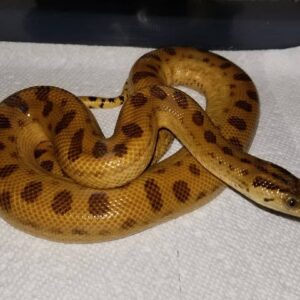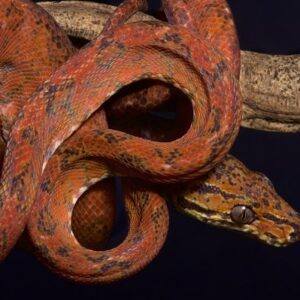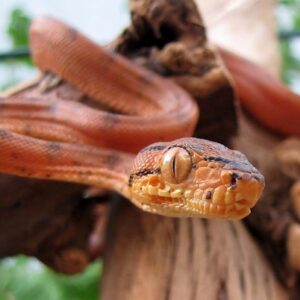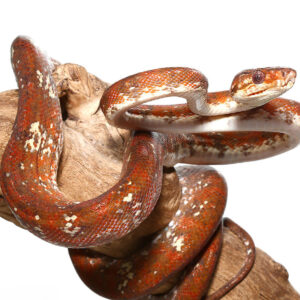Elegant Pit Viper For Sale
$999.99
WE HAVE A ELEGANT PIT VIPER PAIR FOR SALE. HERE ARE SOME HIGHLIGHTS:
- Protobothrops elegans
- Captive Bred
- Male And Female Pair
- Approximately 3 – 3.5 Feet In Length
- Adults Can Grow To Approximately 4 – 5 Feet
- Feeding On Frozen Thawed Or Live Small Rats
- *These Are Venomous. Please Know Your State Laws Before Inquiring As Some States Require Venomous Permits*
FUN FACTS!
- Very Toxic Venom, Not For Handling
- Native To The Islands Of Japan
- Lifespan Can Be Anywhere From 12 – 18+ Years
Description
The elegant pit viper, scientifically known as Protobothrops elegans, is a fascinating species within the viper family, distinguished by its striking appearance and intriguing behavior. Renowned for its exquisite patterns and coloration, this viper boasts a series of unique features that set it apart from other snake species. Its scales exhibit a blend of earthy tones, often with intricate bands or spots that provide excellent camouflage within its natural habitat. This remarkable adaptation not only enhances its survival but also adds to its allure among herpetologists and nature enthusiasts.
Native to the subtropical and tropical regions of Southeast Asia, the elegant pit viper primarily inhabits forested areas, often favoring dense underbrush and rocky outcrops. This preference for secluded environments underscores its elusive nature, making encounters with this snake a rare and memorable experience. Its habitat selection is driven by the need for both cover and suitable conditions for thermoregulation, a critical aspect of its ectothermic physiology.
Behaviorally, the elegant pit viper is predominantly nocturnal, exhibiting peak activity during twilight and nighttime hours. This nocturnal lifestyle is complemented by its specialized heat-sensing pits, located between the eyes and nostrils. These pits enable the viper to detect warm-blooded prey with remarkable precision, even in complete darkness. This highly developed sensory system is a hallmark of pit vipers and plays a crucial role in their hunting strategy.
In addition to its sensory capabilities, the elegant pit viper is known for its relatively calm demeanor when compared to other venomous snakes. While it possesses potent venom, which it uses primarily for subduing prey, it typically exhibits a reserved and non-aggressive disposition towards humans. This characteristic, coupled with its captivating beauty and ecological significance, makes the elegant pit viper a subject of great interest and admiration in the field of herpetology.
Habitat and Distribution
The elegant pit viper, scientifically known as Trimeresurus elegans, exhibits a remarkable adaptability to various environments, typically favoring subtropical and tropical regions. These snakes are predominantly found in the dense forests and mountainous terrains of Southeast Asia. Countries such as Thailand, Vietnam, Laos, and parts of southern China constitute their primary geographical range. The tropical climate of these regions, characterized by high humidity and ample rainfall, provides an ideal habitat for the elegant pit viper.
Within these countries, the elegant pit viper often occupies altitudes ranging from lowland areas to elevations as high as 1,500 meters. The snake’s habitat choice is influenced by the availability of prey, such as small mammals, birds, and amphibians, which thrive in these lush environments. Furthermore, the dense foliage and underbrush in these regions offer the pit viper suitable camouflage and shelter, essential for both hunting and protection from potential predators.
Although primarily arboreal, the elegant pit viper can also be found on the forest floor, particularly during the cooler months. Seasonal variations in temperature and precipitation influence their activity patterns and distribution. During the wet season, these snakes are more active and can be found at various altitudes. In contrast, the dry season may see them retreat to more stable microhabitats, such as burrows or rock crevices, to maintain hydration and avoid extreme temperatures.
There are no significant migratory patterns observed in the elegant pit viper. However, local movements within their habitat are common, primarily driven by the search for food and mates. The adaptability of the elegant pit viper to different environmental conditions underscores its resilience and contributes to its widespread presence across its native range. Understanding the habitat and distribution of the elegant pit viper is crucial for conservation efforts and for ensuring the species continues to thrive in its natural environment.
Physical Characteristics
The elegant pit viper, known for its striking appearance, exhibits a range of physical characteristics that contribute to its survival in the wild. Typically, these vipers measure between 60 to 80 centimeters in length, with females generally being larger than males. Their slender bodies are covered in keeled scales, which add a rough texture and aid in camouflage within their natural habitats.
Coloration of the elegant pit viper varies widely, often reflecting the environment they inhabit. Commonly, these vipers display hues of green, brown, and yellow, interspersed with darker patterns. This coloration provides an excellent means of blending into foliage, leaf litter, and forest floors, making them less visible to both predators and prey. Unique to these vipers are the distinct, often symmetrical, markings along their backs, which can include bands, spots, or blotches. These patterns not only serve a camouflaging function but also play a role in thermoregulation by allowing the viper to absorb or reflect sunlight more efficiently.
One of the most notable features of the elegant pit viper is the presence of heat-sensing pits located between the eyes and nostrils. These pits enable the viper to detect infrared radiation, allowing it to locate warm-blooded prey even in complete darkness. The head of the elegant pit viper is typically triangular and distinguished from the neck, a common trait among venomous snakes. Additionally, their eyes are equipped with vertical, elliptical pupils, enhancing their ability to judge distance and movement, particularly in low-light conditions.
These physical attributes not only define the elegant pit viper’s appearance but also enhance its adaptability and effectiveness as a predator. The combination of camouflage, heat-sensing capabilities, and keen vision enables this viper to thrive in diverse ecosystems, from dense forests to rocky outcrops. Through an intricate blend of form and function, the elegant pit viper exemplifies the evolutionary prowess of reptiles.
Behavior and Diet
The elegant pit viper exhibits a range of intriguing behavioral traits that contribute to its mystique and survival in the wild. This reptile is primarily nocturnal, engaging in most of its activities under the cover of darkness. During daylight hours, it remains relatively inactive, often curled up in shaded, secluded spots to avoid predation and conserve energy. The viper’s nocturnal behavior is a strategic adaptation that allows it to exploit the cooler, quieter hours of the night for hunting and other activities.
When it comes to hunting, the elegant pit viper employs a sit-and-wait strategy. It relies heavily on its exceptional camouflage and stillness to blend into its environment, making it nearly invisible to both prey and predators. The viper’s heat-sensing pit organs play a crucial role in detecting warm-blooded prey, such as small mammals and birds. These specialized sensory organs allow the snake to accurately strike at its target, even in complete darkness.
The diet of the elegant pit viper is primarily carnivorous, consisting of a variety of small animals. Rodents are a staple in its diet, providing a rich source of nutrients. It also preys on birds, lizards, and occasionally amphibians. The hunting technique of the elegant pit viper is characterized by a swift, precise strike followed by the injection of potent venom. This venom not only immobilizes the prey but also begins the digestive process even before the prey is consumed.
Feeding habits of the elegant pit viper are opportunistic. It does not require daily meals and can go for extended periods without feeding, making the most of each successful hunt. After capturing its prey, the viper will consume it whole, headfirst, using its flexible jaw structure to accommodate larger prey items.
Overall, the elegant pit viper’s behavior and diet reflect its adaptability and efficiency as a predator. Its unique hunting methods, coupled with its specialized sensory adaptations, make it a formidable and fascinating creature in its natural habitat.
Venom and Its Effects
The elegant pit viper, renowned for its striking appearance and potent venom, harbors a complex biochemical cocktail within its venom glands. The venom primarily comprises proteins and enzymes, including hemotoxins and neurotoxins, which facilitate the immobilization and digestion of prey. Hemotoxins target the circulatory system, causing hemolysis, coagulopathy, and tissue damage, while neurotoxins interfere with nerve signal transmission, leading to paralysis.
When the elegant pit viper strikes its prey, the venom swiftly incapacitates the victim, ensuring the viper can consume its meal with minimal resistance. The potency of the venom varies depending on factors such as the snake’s age, diet, and geographic location. Generally, the venom is highly effective against small mammals and birds, which constitute the viper’s primary diet.
For humans, a bite from the elegant pit viper can have severe medical implications. Symptoms typically manifest rapidly and may include intense pain, swelling, bruising, and blistering at the bite site. Systemic effects can include nausea, vomiting, dizziness, difficulty breathing, and in severe cases, hemorrhage or organ failure. Immediate medical attention is crucial to mitigate these potentially life-threatening symptoms.
Treatment protocols for an elegant pit viper bite involve several critical steps. Firstly, immobilizing the affected limb and keeping it at or slightly below heart level can help slow the spread of venom. Antivenom administration is the cornerstone of medical treatment, neutralizing the venom’s toxic effects. Supportive care, such as pain management, intravenous fluids, and monitoring for potential complications, is also essential. In some cases, surgical intervention may be necessary to address necrotic tissue or other severe damage.
Understanding the elegant pit viper’s venom and its effects underscores the importance of caution and respect when encountering these remarkable reptiles. Awareness and prompt medical response can significantly enhance outcomes for those affected by a bite.
Reproduction and Lifespan
The reproductive cycle of the elegant pit viper is a fascinating aspect of its biology. These snakes exhibit a range of unique mating behaviors that ensure the continuation of their species. Mating typically occurs during the warmer months when both males and females are more active. Males engage in combat with each other to win the favor of receptive females. Such combat involves intricate wrestling matches, with each male attempting to pin his rival to the ground.
Once mating has successfully taken place, the female elegant pit viper undergoes a gestation period that generally lasts between six to nine months. Unlike many other reptiles, these snakes are ovoviviparous, meaning that the young are born live rather than hatching from eggs outside the mother’s body. The number of offspring can vary widely, ranging from five to twenty neonates per litter, depending on the female’s age and health.
The birth process itself is relatively quick and occurs in a secure, secluded location to ensure the safety of the newborns. At birth, the young vipers are fully independent and equipped with the necessary skills to hunt and fend for themselves. Their initial diet consists mainly of small insects and gradually evolves to include larger prey as they grow.
The average lifespan of an elegant pit viper in the wild is estimated to be around 10 to 15 years. However, this can be influenced by several factors including predation, availability of food, and habitat conditions. In captivity, where these factors are controlled, these snakes can live even longer, sometimes reaching up to 20 years. Regular health check-ups and a stable environment are crucial for maximizing their longevity.
In summary, the elegant pit viper’s reproduction and lifespan are marked by distinctive behaviors and environmental interactions. Understanding these aspects not only enriches our knowledge of this species but also emphasizes the importance of their conservation.
Conservation Status and Threats
The elegant pit viper, scientifically known as Protobothrops elegans, occupies a precarious position in the ecosystem due to a multitude of threats. Currently, the elegant pit viper is classified as a species of least concern by the International Union for Conservation of Nature (IUCN). However, despite this classification, the population of these reptiles is experiencing gradual decline, largely attributed to both natural and anthropogenic factors.
One of the most significant threats to the elegant pit viper is habitat destruction. The rapid expansion of urban areas, coupled with deforestation for agricultural purposes, has led to the fragmentation of the viper’s natural habitat. This loss of habitat not only reduces the available territory for the species but also disrupts their hunting and mating behaviors, which can have cascading effects on their population dynamics.
Climate change further compounds the challenges faced by the elegant pit viper. Shifts in temperature and precipitation patterns can alter the availability of prey and suitable habitats. Such environmental changes force these reptiles to adapt rapidly or face increased mortality rates. With the ongoing impact of global warming, the elegant pit viper may find its survival increasingly jeopardized.
Human activities also pose direct threats to the elegant pit viper. These include illegal poaching for the exotic pet trade and the killing of these snakes out of fear or misunderstanding of their role in the ecosystem. Additionally, the use of pesticides and other chemicals in agriculture can lead to poisoning and a decrease in prey populations, indirectly affecting the viper’s ability to thrive.
In response to these threats, various conservation efforts have been initiated. Habitat protection and restoration projects aim to preserve and expand the natural environments where the elegant pit viper resides. Environmental education programs are also crucial, helping to shift public perception and reduce human-wildlife conflicts. Furthermore, anti-poaching laws and regulations on the trade of exotic animals are being enforced to safeguard these reptiles from illegal activities.
Through concerted conservation efforts and increased awareness, there is hope that the elegant pit viper can continue to be a vital component of biodiversity, maintaining its ecological role within its natural habitat.
Interesting Facts and Myths
The elegant pit viper, known for its striking appearance and distinctive heat-sensing capabilities, is a subject of various fascinating facts and myths. One of the most remarkable features of this species is its heat-sensing pits located between the eyes and nostrils. These pits are highly sensitive to infrared radiation, allowing the viper to detect warm-blooded prey even in complete darkness. This unique adaptation not only aids in hunting but also enhances its survivability in diverse environments.
Contrary to popular belief, not all pit vipers are aggressive. The elegant pit viper, in particular, is known to be relatively docile when compared to other viper species. They usually prefer to avoid confrontation and will only strike if they feel threatened or cornered. This misconception often leads to unnecessary fear and overestimation of the danger they pose to humans. Understanding their behavior can help in fostering a more balanced perspective on these reptiles.
Another intriguing fact about the elegant pit viper is its reproductive cycle. Unlike many other reptiles that lay eggs, the elegant pit viper gives birth to live young. This process, known as ovoviviparity, ensures that the offspring have a higher chance of survival as they are born fully formed and ready to fend for themselves. This adaptation is particularly beneficial in their native habitats, which can be harsh and unpredictable.
Among the myths surrounding the elegant pit viper is the belief that their venom is always lethal. While their venom is potent and can cause significant harm, it is not necessarily fatal to humans if medical treatment is promptly administered. Modern antivenoms have significantly reduced the mortality rates associated with viper bites. Additionally, the elegant pit viper’s venom has been found to contain compounds with potential medicinal properties, offering promising avenues for scientific research.
By debunking these myths and shedding light on lesser-known facts, we can appreciate the elegant pit viper not merely as a fearsome predator but as a remarkable species with unique adaptations and behaviors. This understanding not only enriches our knowledge but also contributes to the conservation efforts aimed at protecting these fascinating reptiles and their natural habitats.



